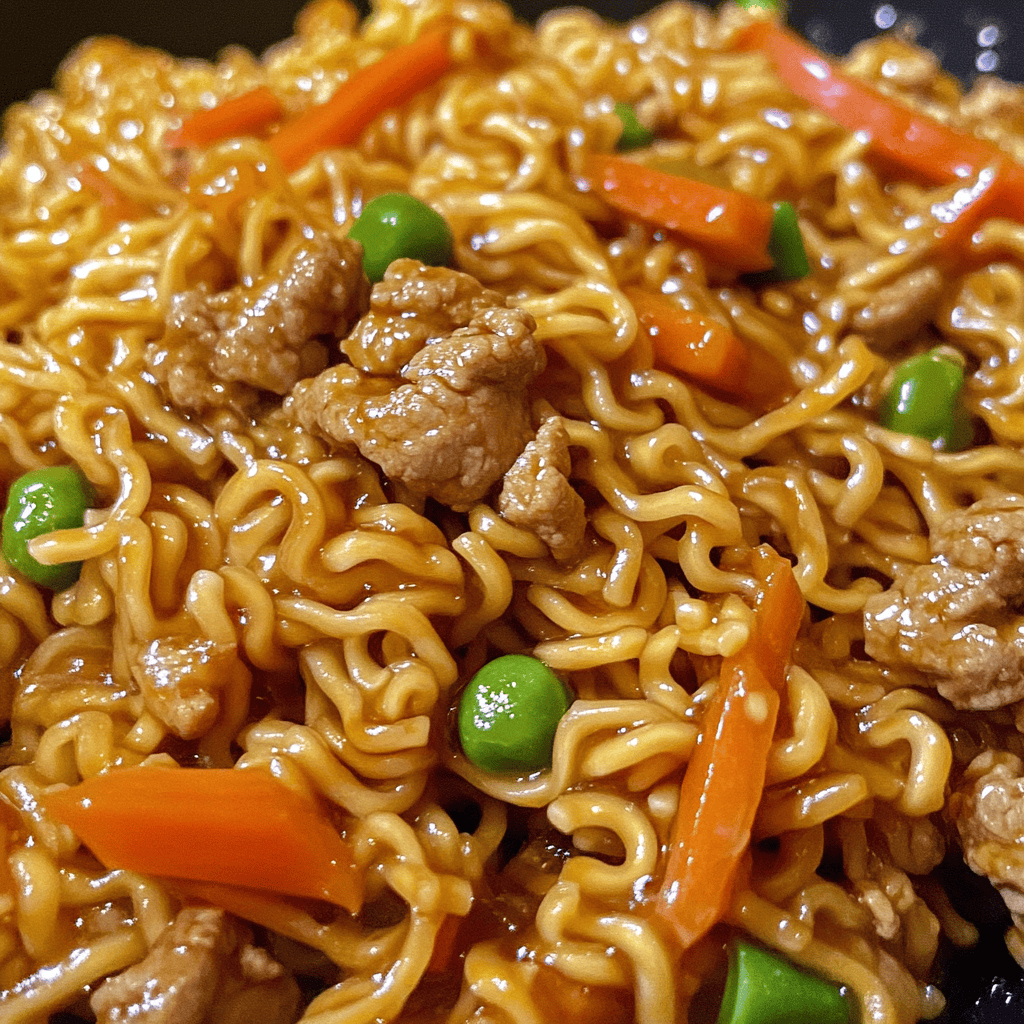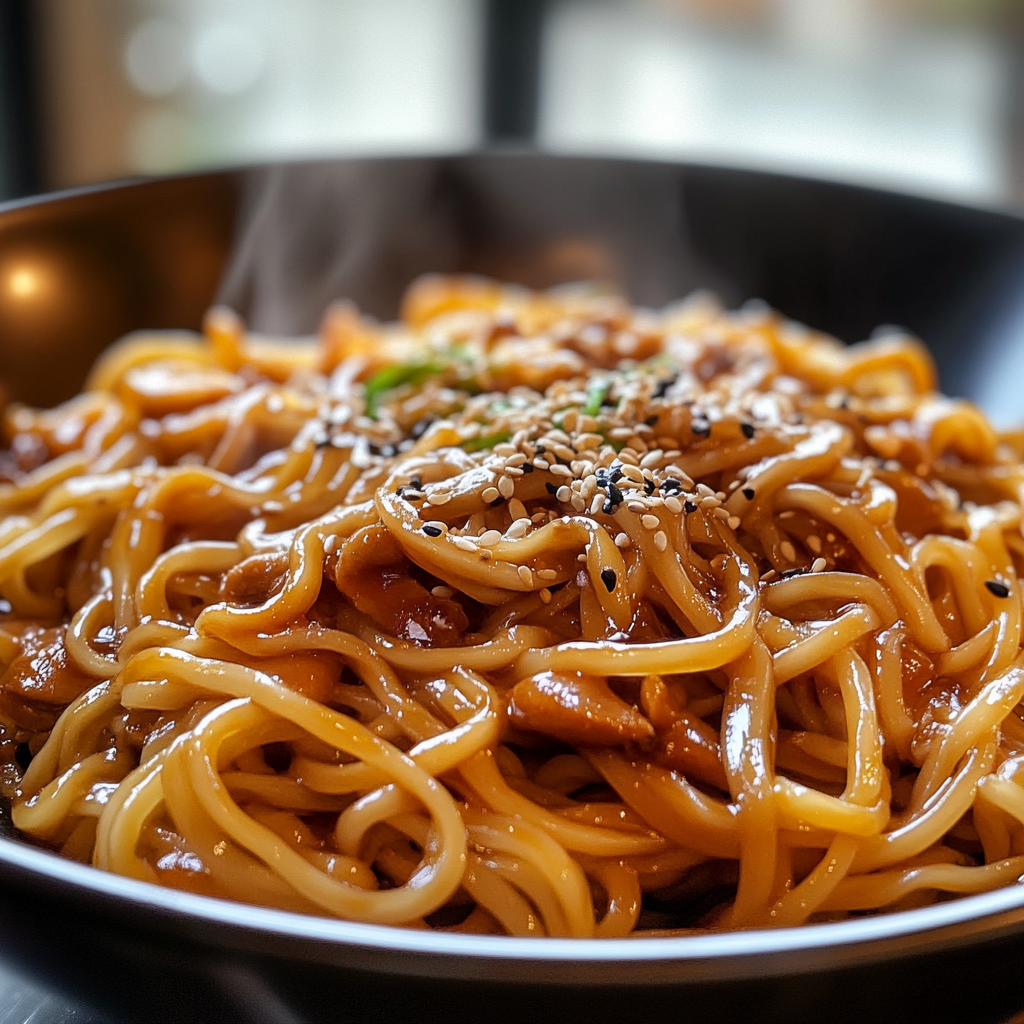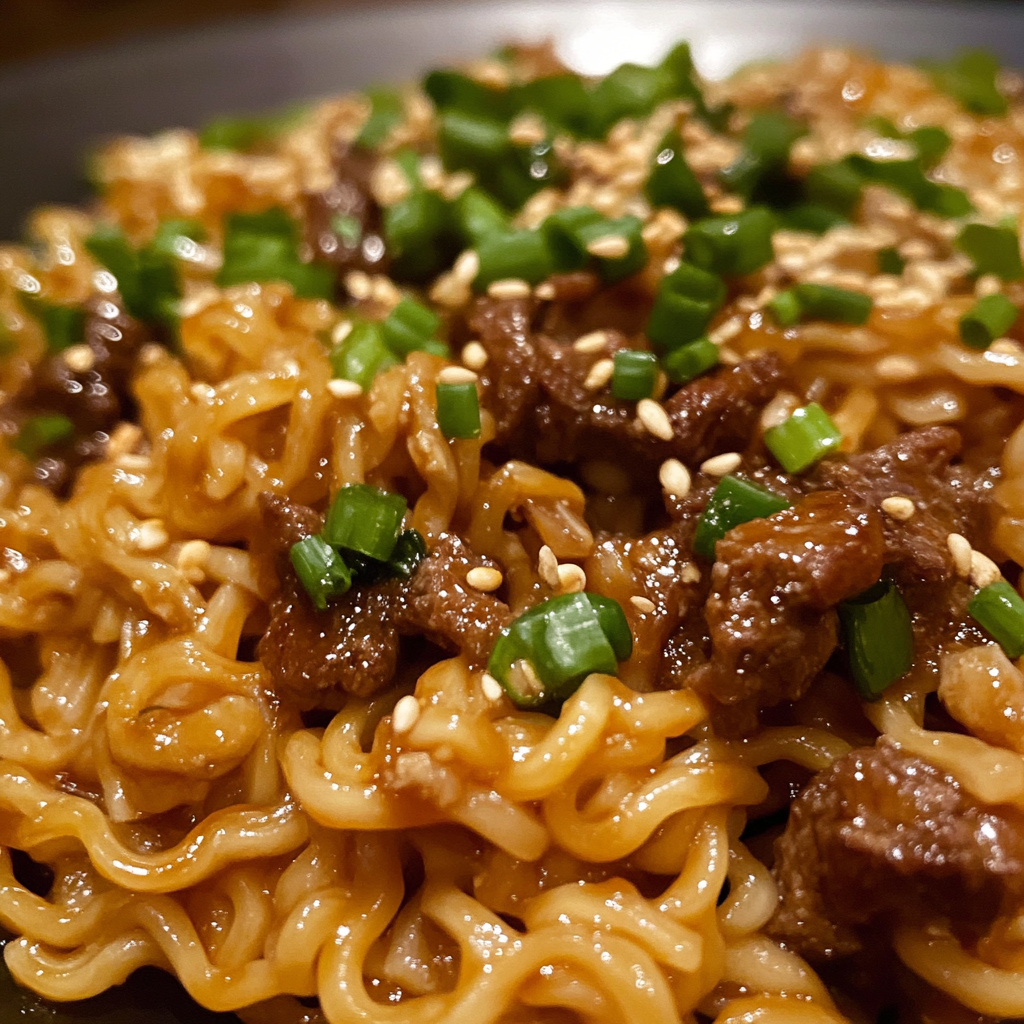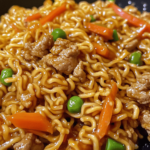Quick Overview
Hibachi Noodles are a delightful dish that brings the taste of Japanese restaurants straight to your kitchen. With their savory flavor and satisfying texture, these noodles are a fantastic option for any meal. This recipe is easy to follow and allows you to create a restaurant-quality dish in no time. Perfect for busy weeknights or special occasions, hibachi noodles will impress family and friends alike.
Ingredient Breakdown
Soy Sauce
Soy sauce is a fundamental ingredient that adds depth and umami to hibachi noodles. For this recipe, you will need 1/4 cup of low-sodium soy sauce. Its rich flavor complements the other ingredients perfectly.
Garlic
Garlic brings an aromatic punch to the dish. You will need 2 cloves of minced garlic for this recipe. It infuses the oil with its distinct taste, enhancing the overall flavor profile.
Ginger
Fresh ginger adds warmth and spice to the noodles. Use about 1 tablespoon of grated ginger to achieve that authentic hibachi taste. Its bright notes balance out the richness of the soy sauce.
Vegetables
A colorful mix of vegetables makes hibachi noodles visually appealing and nutritious. You will need 1 cup each of sliced bell peppers, carrots, and broccoli. These add crunch and sweetness to every bite.
Noodles
The star of the dish is undoubtedly the noodles themselves. Use 8 ounces of thick udon or ramen noodles for optimal texture. They soak up flavors well and provide a hearty base for your meal.
Sesame Oil
Sesame oil contributes a nutty aroma and flavor that completes the dish. Use 2 tablespoons of toasted sesame oil for cooking. It elevates the taste profile while adding richness.
Step By Step Recipe: Hibachi Noodles
Prepare the Ingredients
Start by preparing all your ingredients before cooking. Slice the vegetables into thin strips for even cooking, mince the garlic and grate the ginger. Cook your chosen noodles according to package instructions until al dente, then drain and rinse under cold water to stop cooking.
Heat Up Your Pan
In a large skillet or wok, heat 2 tablespoons of sesame oil over medium-high heat. Ensure that the pan is hot before adding ingredients; this helps achieve that signature stir-fry texture that makes hibachi dishes so enjoyable.
Sauté Garlic and Ginger
Once your pan is hot, add minced garlic and grated ginger. Stir them quickly for about 30 seconds until fragrant but not burnt. The aroma will fill your kitchen, setting up an exciting cooking atmosphere.
Add Vegetables
Next, toss in your sliced bell peppers, carrots, and broccoli into the hot pan. Stir-fry these vibrant veggies for about 3-5 minutes until they start to soften but still retain some crunch. This ensures they stay fresh while absorbing all those wonderful flavors.
Incorporate Noodles
Now it’s time to add your cooked noodles into the pan with sautéed vegetables. Gently toss everything together using tongs or a spatula to combine evenly without breaking any noodles apart.
Pour Soy Sauce Mixture
In a small bowl, mix together soy sauce with any additional seasonings you desire (like chili flakes). Pour this mixture over your noodle-vegetable blend in the skillet while continuing to toss everything together evenly for another minute or so until fully incorporated.
Serve Hot
Once everything is heated through and combined nicely, remove from heat immediately to prevent overcooking. Plate your delicious hibachi noodles hot from the stove! Garnish with sesame seeds or chopped green onions if desired for added presentation.
Serving and Storing Tips
Serving Suggestions
Serve hibachi noodles immediately after cooking while they’re still warm. They pair wonderfully with grilled chicken or shrimp for added protein options on top of these flavorful vegetables! Consider adding extra soy sauce at the table for those who enjoy more seasoning.
Leftovers Storage
If you have leftovers after enjoying this delicious meal, store them in an airtight container in the refrigerator for up to three days. Reheat gently on low heat in a skillet with a splash of water or additional sesame oil to maintain moisture during reheating.
Enjoy making these delightful hibachi noodles!
Mistakes to avoid
One common mistake when preparing hibachi noodles is overcooking them. Overcooked noodles become mushy and lose their texture. To avoid this, cook the noodles according to package instructions and quickly cool them under cold water after draining. This stops the cooking process and preserves their firmness.
Another error is neglecting to season adequately. Hibachi noodles benefit from a balance of flavors, so don’t skip the soy sauce or other seasonings. Taste as you go and adjust seasoning to your preference. A well-seasoned dish enhances all ingredients.
Using too much oil during cooking can lead to greasy noodles. Instead, use just enough oil to coat the pan. This keeps the dish light and allows the flavors of your vegetables and proteins to shine through without overwhelming them.
Not prepping ingredients beforehand is another mistake. Hibachi cooking is quick, so having all your ingredients prepared in advance ensures everything cooks evenly and efficiently. Chop vegetables, measure sauces, and have everything ready before you start cooking.
Lastly, overcrowding the pan can cause steaming instead of frying. Cook in smaller batches if necessary to achieve that delicious charred flavor characteristic of hibachi-style dishes. This ensures each ingredient gets the proper heat treatment.
Tips and tricks
To achieve perfect hibachi noodles, start with high-quality noodles. Fresh or handmade varieties provide superior texture compared to dried ones. If using dried noodles, choose a type that fits your recipe well, such as udon or soba for an authentic taste.
Next, consider using a wok or a large skillet for cooking. These pans allow for even heat distribution and plenty of space for tossing ingredients without making a mess. High heat is crucial in hibachi cooking; it helps create that signature sear on your vegetables and proteins.
When choosing vegetables, opt for colorful varieties like bell peppers, carrots, and broccoli. Not only do they add visual appeal, but they also enhance the overall flavor profile of your dish. Cut them into uniform sizes for even cooking.
Don’t forget about protein options! Chicken, shrimp, or tofu can elevate your hibachi noodles significantly. Marinate them briefly in soy sauce or sesame oil for added depth of flavor before cooking.
Finally, garnishing with green onions or sesame seeds adds both flavor and texture to your finished dish. A sprinkle at the end brings freshness and a touch of elegance to your hibachi noodles.
Suggestions for Hibachi Noodles
For a unique twist on traditional hibachi noodles, try adding some spice with chili garlic sauce or sriracha during cooking. This gives your dish an extra kick without overwhelming other flavors.
Another suggestion is to include seasonal vegetables based on availability. Fresh produce not only tastes better but also adds nutritional value to your meal. Consider adding zucchini in summer or squash in autumn for variety.
If you’re looking for a vegetarian option, swap out meat for tempeh or seitan as protein alternatives in your hibachi noodle dish. Both absorb flavors beautifully while offering excellent texture.
Experimenting with different sauces can also enhance the experience of hibachi noodles. Try teriyaki or hoisin sauces alongside traditional soy sauce for a different taste dimension that complements stir-fried ingredients beautifully.
Lastly, serving hibachi noodles with a side of pickled ginger can balance out flavors nicely while providing an interesting contrast to savory tastes present in the main dish.
FAQs
What are hibachi noodles?
Hibachi noodles are typically stir-fried noodles used in Japanese cuisine that feature various vegetables and proteins cooked quickly at high heat in a wok or skillet. They often have a savory flavor enhanced by soy sauce and other seasonings during preparation.
Can I make hibachi noodles vegetarian?
Absolutely! You can easily prepare vegetarian hibachi noodles by using tofu or tempeh as protein sources along with fresh vegetables like bell peppers, broccoli, and carrots tossed together with flavorful sauces like soy sauce or teriyaki sauce.
How long do I cook the noodles?
Cooking time for hibachi noodles varies depending on the type you choose but generally takes around 3-6 minutes once boiling water is reached. Always check package directions for specific timing recommendations tailored to noodle varieties used.
What type of oil should I use for frying?
Using oils with high smoke points such as vegetable oil or canola oil works best when frying hibachi dishes at high temperatures because they resist burning while allowing ingredients like vegetables and meats to stir-fry properly without sticking.
Are there any gluten-free options available?
Yes! You can find gluten-free versions of traditional wheat-based noodles made from rice flour or other gluten-free grains suitable for those avoiding gluten while still enjoying flavorful hibachi preparations at home!
How do I store leftover hibachi noodles?
To store leftover hibachi noodles properly, place them in an airtight container once cooled down completely after cooking—refrigerate them promptly! They will keep well in the fridge for up to three days; reheat thoroughly before serving again!
Summary
In summary, perfecting hibachi noodles involves avoiding common mistakes such as overcooking and improper seasoning while applying helpful tips like choosing quality ingredients and using appropriate cookware techniques effectively. By following these guidelines along with creative suggestions tailored specifically towards enhancing flavors throughout preparation stages—your homemade version will surely impress anyone fortunate enough to share it!
Hibachi Noodles
Description
Hibachi Noodles are a delightful dish that brings the taste of Japanese restaurants straight to your kitchen. With their savory flavor and satisfying texture, these noodles are a fantastic option for any meal. This recipe is easy to follow and allows you to create a restaurant-quality dish in no time. Perfect for busy weeknights or special occasions, hibachi noodles will impress family and friends alike.
Ingredients
Soy Sauce
Soy sauce is a fundamental ingredient that adds depth and umami to hibachi noodles. For this recipe, you will need 1/4 cup of low-sodium soy sauce. Its rich flavor complements the other ingredients perfectly.
Garlic
Garlic brings an aromatic punch to the dish. You will need 2 cloves of minced garlic for this recipe. It infuses the oil with its distinct taste, enhancing the overall flavor profile.
Ginger
Fresh ginger adds warmth and spice to the noodles. Use about 1 tablespoon of grated ginger to achieve that authentic hibachi taste. Its bright notes balance out the richness of the soy sauce.
Vegetables
A colorful mix of vegetables makes hibachi noodles visually appealing and nutritious. You will need 1 cup each of sliced bell peppers, carrots, and broccoli. These add crunch and sweetness to every bite.
Noodles
The star of the dish is undoubtedly the noodles themselves. Use 8 ounces of thick udon or ramen noodles for optimal texture. They soak up flavors well and provide a hearty base for your meal.
Sesame Oil
Sesame oil contributes a nutty aroma and flavor that completes the dish. Use 2 tablespoons of toasted sesame oil for cooking. It elevates the taste profile while adding richness.





